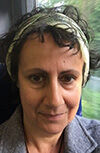Creative Awards Projects
Liza Fletcher
Biography
 I am an established Producer, Filmmaker and Project and Public Engagement & Communities Manager, with particular interest and experience of working with underrepresented and disenfranchised groups in mainstream visual culture. My professional experience spans the small charity sector, education, film, community engagement and using interactive film, VR, and immersive technologies in cultural heritage projects. I do not describe myself as an academic but I wish to use film as a research and documentary tool to describe how we live in the world.
I am an established Producer, Filmmaker and Project and Public Engagement & Communities Manager, with particular interest and experience of working with underrepresented and disenfranchised groups in mainstream visual culture. My professional experience spans the small charity sector, education, film, community engagement and using interactive film, VR, and immersive technologies in cultural heritage projects. I do not describe myself as an academic but I wish to use film as a research and documentary tool to describe how we live in the world.
I recently returned to higher education as a mature student to study for an MA in Visual Anthropology at Goldsmiths College, University of London. As well as learning practical filmmaking skills, the academic focus of the programme was in the representation of minority groups in film and visual culture; and the discussion around the ethical responsibility of the filmmaker to truthfully represent participants in a collaborative and inclusive way.
Outline
In 2017, the British Film Institute screened the 4k remastered version of the Indian cinema classic “Pyaasa” (1957) at its National Film Theatre located at London’s Southbank. Hassan Vawda, a Walthamstow based PhD researcher, filmmaker and community arts producer attended the screenings. He was amazed and disappointed to discover that not only was the cinema under-occupied, but that he was one of the few audience members with Asian heritage, present at the event. The mainly white audience sat in reverence and silence during the film.
When The Barbican Centre’s Community & Neighbourhoods team invited Hassan Vawda to pitch a screening idea for its inaugural Leytonstone Loves Film in 2019, he immediately remembered “Pyaasa” in the community screening style of the Apne Cinema clubs he had attended as a child. Hassan wanted to reproduce the community screening events, at which the audience would eat, drink, talk, sing along and loudly boo and cheer the heroes and baddies accordingly.
In this interview with Hassan Vawda, he reflects on the history of the cinema clubs in the United Kingdom and his own personal mission to create “holding space” experiences connecting diaspora with their culture and community through cinema. The documentary genre is a desktop film where archive clips are edited into the timeline to supplement the interview, undertaken on the Zoom platform in April 2022.
Qiuyan Chen
Biography
Qiuyan graduated from LSE Gender and is the founder of Queer China UK.
Outline
'Exploring the queerness of Chinatown' is a multimedia archive project, aiming to uncover heritage, culture, video documentation, visual symbols, people and more of the British Chinese and even British Asian LGBTQ+ community in London’s Chinatown, to examine the changes in interaction and visual representation within the community over the decades, with a focus on cross cultural exchange and cross-cultural queer romances, to reshape the mainstream cultural landscape, and engage with a wider audience via using various media formats.
Supported by DSMN, School of Media, Birmingham City University.
Muzna Rahman
Biography
 Dr Muzna Rahman is a Senior Lecturer at Manchester Metropolitan University. Her research focuses on contemporary postcolonial writing and film, Gastrocriticism, Gender and Sexuality and Critical Race Studies.
Dr Muzna Rahman is a Senior Lecturer at Manchester Metropolitan University. Her research focuses on contemporary postcolonial writing and film, Gastrocriticism, Gender and Sexuality and Critical Race Studies.
Outline
Titled 'Progressive Islamic Feminism and the Limits of the Sacred: An analysis of We Are Lady Parts (2021', this visual project explores the political potential and limits of feminism within the context of multicultural Britain, with a focus on Muslim women and bodies in the contemporary moment. My analysis of the first season of Channel 4’s dramedy We Are Lady Parts (2021) zones in on the application of a number of intersecting feminisms that can be productively applied to the hybrid zone of British-Muslim identity. By framing this text as an ambivalent site of female Muslim representation, my project seeks to explore the contradictions as well as the radical feminist activisms that may be read into the narrative of We Are Lady Parts. Through visual analysis and critical feminist theory sourced from a variety of geopolitical contexts and scholarly legacies, my reading demonstrates that the British Muslim identity is deeply influenced by postcolonial and diasporic contexts as well as faith-based discourses. These two matrices at times intersect to produce important re-readings of the ‘submissive and oppressed’ Orientalised Muslim female figure, whilst at other times challenge the possibility of a stable Muslim female identity as positioned in normative models of British multiculturalism.
Progressive Islamic Feminism and the Limits of the Sacred
Rahul Gairola
Biography
Dr Rahul K Gairola is a Krishna Somers Senior Lecturer in English & Postcolonial Literature Murdoch University, Greater Perth, Western Australia.
Outline
My presentation examines how queerness disrupts one of the most oppressive family functions in British South Asian diasporic culture – the arranged marriage. It engages in a comparative retrospective of two classic filmic texts: My Beautiful Launderette (1985) written by Hanif Kureishi and directed by Stephen Frears; and East is East (1999) directed by Damien O’Donnell. Both British South Asian diasporic films offer powerful representational alternatives the nationalist heteropatriarchy that characterize Thatcherite England.
I read Kureishi’s and O’Donnell’s cinematic texts as treating heterosexual, arranged marriage as a “glocal” phenomenon that is at once a grand life milestone to publicly celebrate across one’s transnational network of family members, on the one hand, while remaining anchored to social formations in local communities and neighbourhoods, on the other.
I read Tania, Omar, and Johnny in Launderette and Nazir and his partner in East is East as queering agents who disrupt the neoliberal, heteronormative order of arranged marriage that is embedded within the strict Muslim heteropatriarchy of their families. For Omar, Tania, and Nazir, this is especially important as they are liminal diasporic subjects that exists between three worlds: the British, the Pakistani, and the heteronormative. As such, these characters effectively disrupt the discourse of arranged marriage of queer/ non-heteronormative members of the South Asian diaspora in the UK. This process is at once “glocal” as it occurs at the local level of community but also impacts their relatives.
However, I also note that the burden of being queer agents of change that challenge the heteropatriarchy of arranged marriage of the South Asian diaspora in the UK also has its pitfalls. I observe that the romantic union of Omar and Johnny occurs at the expense of Tania, who is literally erased at the end of the film as a convenient way of ensuring the reunion of the two gay men and the security of their capital and assets at the end of Launderette.
In East is East, Nazir too disappears from his family’s home at the very moment he can ensure that his two younger brothers avoid getting forced into arranged marriages. This erasure, along with his stereotypical, effeminate “gayness” undercuts the efficacy of the representations. Nonetheless, both My Beautiful Launderette and East is East offer optics of glocal resistance to enforced arranged marriages of queer diasporic South Asians in the UK.
Nina Edge
Biography
 Nina Edge is an artist, writer and filmmaker based in Liverpool. Her work uses text and translation running through Arabic, Creole, English, Farsi, Gujurati, Hebrew, Hindi, Punjabi, Pushtu, Urdu and European languages including Welsh. Her only language is English and she has produced many viewing experiences that reflect what it is to not understand what is taking place, due to lack of language. This is often achieved by putting the audience in a situation where they are not spoon fed images and information, but instead have to wonder and guess at what is being said. So the audience experiences something of the emotional and intellectual challenge of the language divisions that the work expounds.
Nina Edge is an artist, writer and filmmaker based in Liverpool. Her work uses text and translation running through Arabic, Creole, English, Farsi, Gujurati, Hebrew, Hindi, Punjabi, Pushtu, Urdu and European languages including Welsh. Her only language is English and she has produced many viewing experiences that reflect what it is to not understand what is taking place, due to lack of language. This is often achieved by putting the audience in a situation where they are not spoon fed images and information, but instead have to wonder and guess at what is being said. So the audience experiences something of the emotional and intellectual challenge of the language divisions that the work expounds.
In the creative project for DSMN this interest in language equity, isolation and connection for diasporic populations is experienced via a short film. The film uses found footage and is recorded on a phone. Spoken language is sparse with captions, printed text and found sound providing the content. The work is designed to put the viewer in the shoes of the outsider, leaving much unexplained, available only with thoughtful and repeated viewing. It is an implicit not explicit piece, so the opposite of illustrated essays, power-points, woke-scold works or promotional films which are often a similar duration at 6.5 minutes.
The work exploits visual as well and audio language, looking and listening at two spaces in Birmingham City Centre, a fountain filled civic square, and a book filled civic library. The images speed up and slow down as the reality of language isolation and mother tongue illiteracy is encountered. Two library sequences in particular drill down into this experience. In one the eye travels across book spines on shelves labelled in English as Arabic, Bengali, Farsi, Guajarati, Hindi, Punjabi and Urdu. We see the seven language scripts first slowly and then quickly. Increasing the speed of the footage gives an impression of looking when the looker has lost something, and troubled by what is hidden. Having looked once with a lingering gaze moving from A to Z on the library shelf labels the protagonist speeds up and looks again going quickly from Z to A. Speeding up the frames turns already heard background sounds of the escalator in the library into quickened panicky breath, or as noted in a test screening, a sound like a steam train or a panting dog. In another single sequence a selection of books, one from each of section outlined above is turned over on a table at speed. However, after a second slower single shot of our seeker, single handedly thumbing through the book pile, filming the pages turn with a phone in her other hand as the pages roll. The page turning single shot is over three minutes in duration and is the core experience of the piece. All that is heard is the sound of books, like a journey through time to a place where creaking hardback covers, and soft pages falling connect all the people associated with the volumes on the table.
The fountains play different sequences, each provoking different emotions from loudly ordered and energetic, to meandering and sporadic, mesmeric, barely audible and silent. A nearby building is formed, it seems, from overlapping circles reminiscent of Muslim patternmaking and a series known to westerners at least as ‘the flower of life’. The protagonist approaches the building which turns out to be a library with a diaspora drenched poster on its window. Outside the sounds of the water falling are used to reflect the stresses of dealing with lost languages, slowing to calmer settled waters by the close of the work. The film closes with the artist’s poem reconciling the cultural illiteracy of ‘third identity’ children of migrants which sees the birth of new and overlapping forms. The title frame ‘Overlapping’ is positioned at the end of the work, to reflect what the protagonist has leaned from the books. So, the right to left reading practice of the books viewed creeps into the film grammar.
The new work engages with the pervasive expectation – the compulsion to the English language in moving image screen media as witnessed by entry criteria to festivals and viewing platforms. The new title ‘Overlapping’, replaces the working title (Pitfall) being more appropriate to the content as developed in production, and favored by people at test screenings in Liverpool and Bristol. This is a reference to the two sites where the film was shot: one the frequent shots of the overlapping and intersecting ripples in several fountain sequences; the other the architecture of the library which uses overlapping circles across its façade.
Priyanka Tripathi
Biography
Priyanka Tripathi is an Associate Professor of English and Head, Department of Humanities and Social Sciences, Indian Institute of Technology Patna (India). She has published extensively with Indian Literature, Journal of Graphic Novels and Comics, Journal of Gender Studies, Economic and Political Weekly amongst others. She has grants from reputed forums: JIWS fellowship 2021-22 (Bridgewater State University), Shastri Conference and Lecture Series Grant (SCLSG) 2021-22, Postcolonial Association grant 2020-21, ICSSR project 2021, TIH Project 2021-22, CIIL conference grant 2020 amongst others. She has also been awarded Visiting Research Fellowship to IASH, University of Edinburgh for the term, April-June 2023. She is the co-Executive Editor of Journal of International Women’s Studies (Bridgewater State University). She works in the area of Gender Studies, South Asian Fiction, GeoHumanities and Graphic Novels.
Outline
“In some cases, wives are abandoned in India: the man marries her, takes the dowry, and never returns. In others, the woman is taken overseas, abused and deserted… (Jain).”
Owing to globalisation, technological advancements and the digital revolution, marriage as an institution has experienced profound changes over a period of time. Mostly superficial, these changes don't impact the core construct of marriage which still remains in a phallocentric hold that controls and regulates a woman’s life and identity without being ‘a subject of inquiry’ (Singh 55). Even in the diasporic space, where mostly ‘transnational marriages’ (Charsley 14; Charsley and Shaw 335; Gardner 374) or ‘international marriages’ (Toyota 1) occur, a conjugal union between the members of a diaspora and of its homeland (Charsley 31) witnesses sham marriages and leave behind a complex site of domestic violence intersecting with other concerns such as forced marriage, economic exploitation, stark cultural dissonance amongst others. This article locates the ‘spectrum of arranged marriage in British Asian diaspora’ through an intersectional reading of select British/Asian cinematic texts: Provoked (2006), Namastey London (2007), Cocktail (2012), Queen (2013).
A detailed analysis of these films, essentially about Indians migrating to London as a consequence of marriage, argues that marital relationships in the diasporic space are rife with dialectics of conflict. Caught between the vortex of homeland ethos and foreign aspirations, tradition and modernity, dependence and independence they are unable to break the walls of the socio-cultural conditioning they have been raised with. At the same time, they also mark a paradigmatic shift in the agency of women and their attempt to conjure a space of resistance beyond the institution of marriage, from the limits of domesticated liberation to one of self-identification/realization. Thus, this article also attempts at revisiting these works as totems from the past to address a problem, drastically present in experiences.
In the Indian context, marriage mobility is one of the primary contributors to the British Diaspora. Data reveals that the largest ethnonational group in London with a population of around 542857 is the British Indians. However, the primary purpose of getting married has witnessed a slow but conspicuous drift from the choice of a partner with the same language, culture and other related practices that go into our day to day “lived experience” (Burch 133; Merleau-Ponty xxvii). The transformation redefines the discourse of marriage as conceived from time immemorial within an Indian context. The agency hardly gets rendered for women as they are kept in the dark concerning the newly emerging semantics of overseas marriages. One of the defining factors concerning conjugal communions abstracts the narrative (in the name of trust and purity) and epitomizes the sanctity of the institution.
In Search of Agency and Self Mapping Gendered Conjugal Violence in Diasporic Diegesis